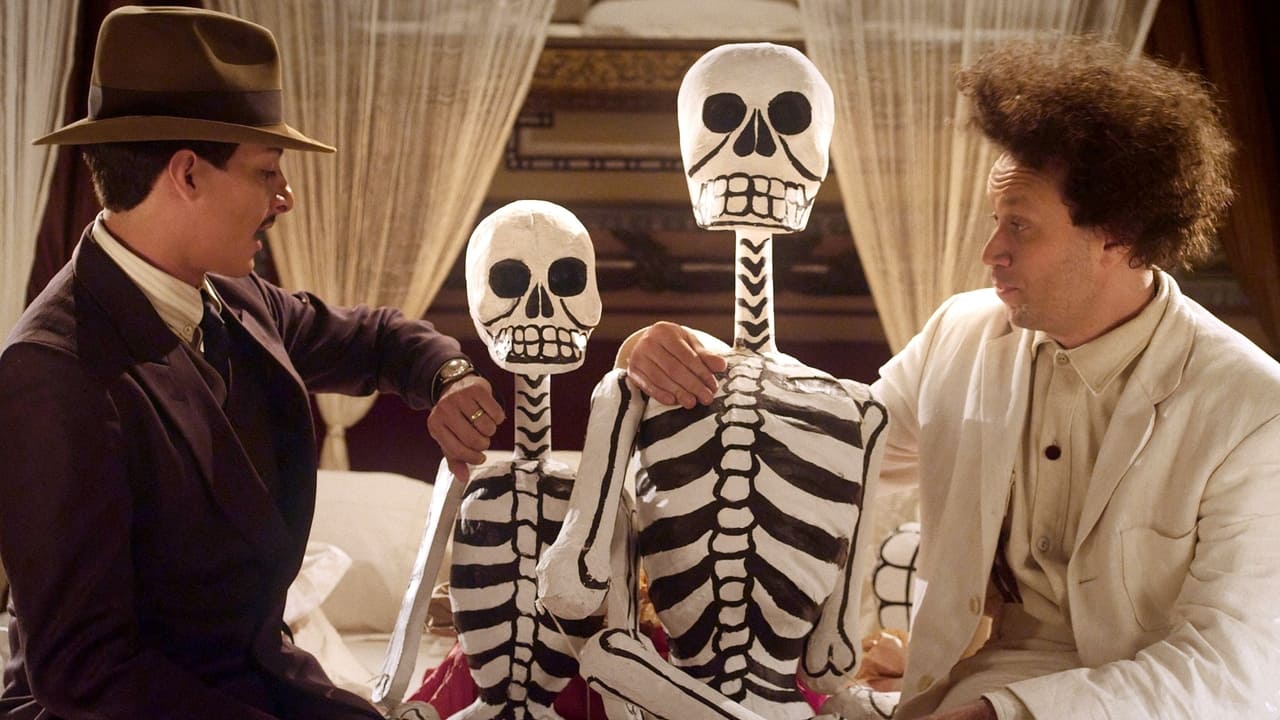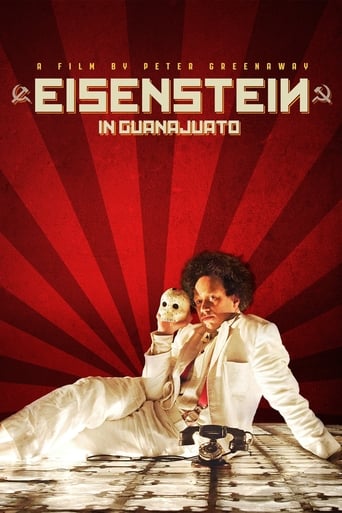

Elmer Back plays Eisenstein (where did they find this guy?). Back's performance is magnetic and mesmerizing, one of my favorites of the year. Back brings a wonderful sense of humor to the film and is an outstanding physical actor/comedian. His slight facial gestures and mannerisms bring a full depth of dimension to his portrayal of Sergei Eisenstein. His frenetic, manic energy with a resting heart rate of about 150 beats per minute is simply a wonder to watch and in perfect step with the film's visual explosiveness. Biopics (by the way this is a VERY loose biopic) are exceptionally easy to make bad, pretty easy to make mediocre, hard as s**t to make good and nearly impossible to make unique. So it comes as no surprise that it a truly formula shattering biopic covering one of the most wildly innovative, complex and enigmatic geniuses in the history of cinema (or in the world).It's the thirties and Soviet film pioneer and Stalinists propagandists Sergei Eisenstein has been shunned by Hollywood for his obvious Red connections and on taking advice by friends such as Charlie Chaplin has gone to Mexico to make his next great "Masterpiece!" Which is more than a struggle, for as the audience slowly finds out, largely in manic diatribes spouted by Eisenstein himself, the legendary auteur is in a highly confused and vulnerable state in his life: financially, politically, sexually, philosophically and artistically. The set pieces in Eisenstein explode in glorious color imposed in fine tuned geometric framing; the depth of staging creates a world within a world, making the sets in Guanajuato a place that existed yet never quite existed. Greenaway in homage to Eisenstein uses many of his techniques montage editing, curt shots, quick scenes that suddenly cut in about three seconds just as Eisenstein, Aleksandr Dovzhenko, Dziga Vertov or other similar montage formalists such as Abel Gance would have. The difference in Greenaway's adoption and mixing of his own techniques with those classic reverence styles is that he maintains continuity in style yet never grows too predictable with his camera and never falls into the deathtrap that is nauseating Tarantino-esque pastiche. Greenaway's use of wide-angle lenses and wonderful tracking dolly shots (reminiscent of Max Ophuls) to follow the frenzied, perpetually moving Eisenstein to-and-fro is amazing and never misses a beat. At certain points Greenaway splits the screen using classic clips of Eisenstein's films and photographs of people that are being referenced as Eisenstein speaks, putting on full display the classic stylings of classic art-cinema, all the while maintaining an air of freshness.Back's performance can become much too some, but in all of Eisenstein's rambling monologues one becomes aware of this man's inner feelings, his emotions that swing from one pole to the next, his true feelings about the Soviet Bear, his fears, his eccentricities, his hang-ups, his diva-bility, as well as his true genius. While the story may seem to remain a bit too vague for some, the devil is in the details. Greenaway is not the man that is going to do a traditional deep-sea delving into the life a character. In Eisenstein Greenaway methodically externalizes the director's philosophies on life and art (and the machinations behind art). We learn about Eisenstein through simple, seemingly unimportant instances (in terms of the man's work), like how he falls for his Mexican chaperone Palomino (Luis Alberti), who eventually anally deflowers Eisenstein in a very funny, touching, matter of fact scene that I assume made many audience members cringe uncomfortably. There are also a few striking scenes with skeletons and a skull; Eisenstein becoming truly enamored with all of this imagery that's semiotics recall the mystery and exotic pageantry of "The Day of the Dead." The Day of the Dead Eisenstein was very much interested in how the mind processed associations and I couldn't help but to think of the hopeless drunk Albert Finney played in John Huston's Mexico-set film Under the Volcano, where both Eisenstein and Finney's characters mirror each other in a particular way. Both are confused, wasting their talents, lost, lost in an existential sense and lost in a foreign place. Eisenstein in Guanajuato is crucially underrated. For fans of Eisenstein it is a must see and is still enjoyable for fans of film even if unaware of the great Sergei Eisenstein and early cinematic forms, though will certainly miss a lot.
... View MoreI read the reviews for this film by the other writers here and some are so spot on and well informed I feel a bit intimidated writing this short review. This film by Director/writer: Peter Greenaway is spellbinding, modern, surreal, and above all, as other writers expressed, captures the inner spirit of Eisenstein's genius.Just as Guanajuato is geographically located in the center of Mexico this story is focused on Eisenstein discovering his personal center. He wanted to be accepted by Hollywood and they rejected him. In Soviet Russia he glorified the revolution with his film "October" and everyone saw him as an artist but he had to hide the person the artist is. He was a great artist of the cinema but here in Guanajuato Eisenstein finds himself and realizes he doesn't need the approval of his peers to be the person he is. With the companionship of his Mexican guide 'Palomino', performed so wonderfully by Luis Alberti, Eisenstein gives into his own desires, his own needs, and is given the chance (though briefly) to be himself physically, artistically, and intellectually.If anyone wants to see the art of Eisenstein just find one of his movies and you will be stunned by it's grand yet simple photography and story. If you want to see an element of 'the man' that created these remarkable films catch this movie. Here the artist brakes the shackles others have place upon him. But in the end he must return to Soviet Russia and back to judging eyes that are so symbolically shown throughout the movie by the three Mexican men in traditional dress. They represent the establishment, society, they eyes and minds that judge all who try to be who they really are.Great cinema for the thinking person!
... View MoreI have not seen any of Greenaway's previous movies, and while I have seen Potemkin, I barley knew anything about (the actual) Eisenstein going in.What I loved about this movie: The editing is fantastic. It plays around with the format, having real life photos of the characters and the locations next to characters as they are mentioned, playing with angles and positions of the characters, experimenting with colors, and obviously, using montages in a great way. I hope this is all based on Eisenstein's actual writings about the subject, as it is clear that he has thoughts about what movies can do with these tools.That's the one positive thing I have to say about this movie. The characters are stylized into cartoon characters, and the dialog is boring and unengaging. The actual storyline is very forgettable. Greenaway chose to have the movie focus on Eisenstein's experiences in Mexico, but did not include any of the actual movie-making Eisenstein did there. To me, that would have been a more interesting movie - but I can understand that Greenaway had a different vision for this story.The sexual scenes were graphical, but not grotesque or provoking (unless you are provoked by homosexuality).
... View MoreOrdinarily I can take Peter Greenaway or leave him alone -- chiefly the latter. But he really scores this time with a story that has longed to be told.As is known Sergei Eisenstein hoped to work in Hollywood in the early thirties just as sound came in. But thanks to aright-wing campaign (plus its own lack of imagination) Paramount Pictures was scared off from making films of with of the scripts the great Russian director had written : an adaptation of Dreiser's "An American Tragedy" and an original historical drama "Sutter's Gold." The novelist Upton Sinclair stepped in and elected to back a film Eisenstein wanted to make about Mexico. But he knew nothing about film production and less about Eisenstein's highly improvisatory working methods. Under-budgeted and best by problems the shoot was brought to a halt when Sinclair's brother-in-law, Hunter Kimbrough discovered SME was having too much fun south of the border. Moreover he got a gander at the great man's cache of frankly gay pornographic drawings. Eisenstein not only never got to edit "Que Viva Mexico" -- he never even saw the rushes. He returned to Russia where he made "Alexander Nevsky" and "Ivam the Terrible" Sinclair meanwhile had the "Que Viva Mexico" footage sliced and diced into travelogues.This is the backdrop of what Greenaway has done which s to present Eisenstein's Mexican sojourn as a sexual awakening. He falls madly in love (and lust) with a handsome guide. Greenaway brings the full bore of his visual imagination to telling this tale with multiple images and lighting the likes of which hasn't been seen since Sternberg. Elmer Back is superb as SME and Luis Alberti is equally great as his love interest. Not to be missed.
... View More